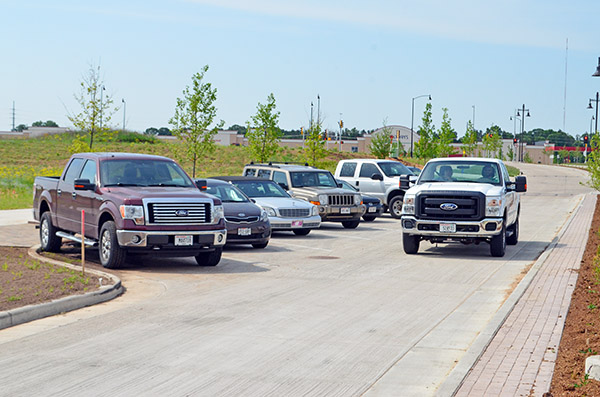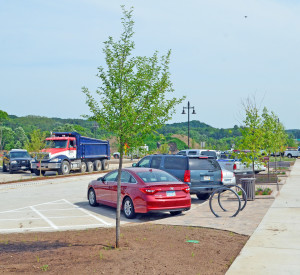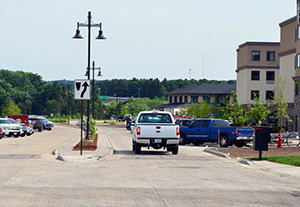Back-in Angle Parking: Easier, Safer

Why Back-in Angle Parking?
- Studies have shown it’s safer and easier than parallel and front-in angle parking
- Visibility is increased for the driver as they leave their parking space
- Eliminates the risk of a driver clipping bicyclists and other motorists while opening their door
Just as roundabouts have taken drivers some time to get used to as they’ve been introduced in many communities, back-in angle parking comes with a learning curve.
A case in point is the brand new River Prairie Development in Altoona, Wisconsin, where some visitors who are checking out the new and under-construction businesses in the rapidly developing area have apparently been puzzled by the parking along several of the new streets. Back-in angle parking is a new concept for this region in west central Wisconsin.
 The parking accommodations along the Ayres-designed Meadowlark Lane, Blazing Star Boulevard, and Bluestem Boulevard in Altoona involve pulling up past an angle parking stall and backing into the stall. Studies have shown back-in angle parking is easier than parallel parking and safer than front-in angle parking, including the better visibility it gives drivers as they leave the parking spot. Advantages of back-in angle parking over parallel parking include eliminating the risk of drivers clipping a bicyclist with their door as they leave their vehicle.
The parking accommodations along the Ayres-designed Meadowlark Lane, Blazing Star Boulevard, and Bluestem Boulevard in Altoona involve pulling up past an angle parking stall and backing into the stall. Studies have shown back-in angle parking is easier than parallel parking and safer than front-in angle parking, including the better visibility it gives drivers as they leave the parking spot. Advantages of back-in angle parking over parallel parking include eliminating the risk of drivers clipping a bicyclist with their door as they leave their vehicle.
 Some drivers in the Altoona development are traveling the wrong way down these divided streets – they’re driving British, you might say – in order to pull into the stalls front-first. Parking signage will arrive soon and should improve the situation. The photos in this post show properly parked cars in Altoona.
Some drivers in the Altoona development are traveling the wrong way down these divided streets – they’re driving British, you might say – in order to pull into the stalls front-first. Parking signage will arrive soon and should improve the situation. The photos in this post show properly parked cars in Altoona.
Here’s an easy step-by-step video, produced for the City of Pensacola, Florida, on how back-in angle parking is done. And here is an Austin, Texas, video that explains the whole safety concept behind it.
Have questions? Contact our Civil + Municipal Engineering division.
Comments
Have you encountered situations that were just not right for back-in parking? We can’t seem to make it work here in Waterford, Pennsylvania. Is it because it’s only two lanes of flowing traffic?
The main challenge is getting public buy-in, so extensive public information efforts would be a good step to take. You may have a little easier time with that in Pennsylvania because back-in angle parking is more common out East as a way to calm traffic and to squeeze in more parking in very narrow streets in older neighborhoods. The public may be more receptive to back-in angle parking on a multi-lane street since they’re not backing up in the only lane of traffic. But that’s not really any different from the usual discomfort with parallel parking.

Post a comment: